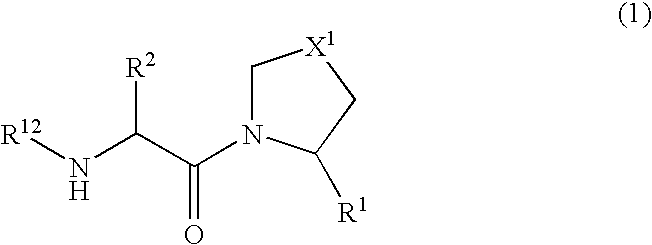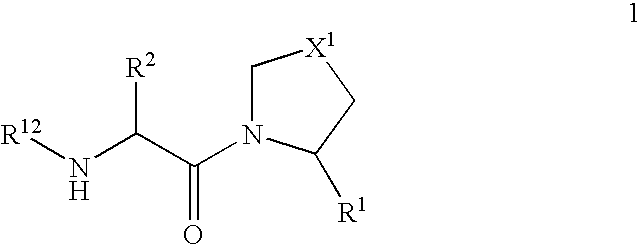Novel dipeptidyl peptidase iv (dp-iv) inhibitors as anti-diabetic agents
- Summary
- Abstract
- Description
- Claims
- Application Information
AI Technical Summary
Benefits of technology
Problems solved by technology
Method used
Image
Examples
example 1
(2S)-1-[Nα-(1′-Acetoxyethoxycarbonyl)-Nω-(pyrazinyl-2-carbonyl)-L-ornithinyl]-pyrrolidine-2-carbonitrile
[0040]
1A. N-(2-Nitrobenzenesulphenyl)-L-proline
[0041] L-Proline (25 g, 217 mmol) was dissolved in 2M NaOH (110 ml, 220 mmol) and dioxan (120 ml). A solution of 2-nitrobenzenesulphenyl chloride (42 g, 222 mmol) in dioxan (60 ml) was slowly added at the same time as 2M NaOH (110 ml, 220 mmol). The mixture was stirred for 2 hours at room temperature then poured into water (500 ml). The solid was removed by filtration. The pH of the filtrate was adjusted to pH3 with 2M HCl and the solution was extracted with ethyl acetate (3×500 ml). The combined organic extracts were washed with water (4×200 ml) and brine (1×200 ml), dried (Na2SO4) and evaporated in vacuo to give an orange solid identified as N-(2-nitrobenzenesulphenyl)-L-proline (58.1 g, 217 mmol, 100%).
1B. N-(2-Nitrobenzenesulphenyl)-L-proline succinimidyl ester
[0042] N-(2-Nitrobenzenesulphenyl)-L-proline (57.9 g, 216 mmol) was...
example 2
(4R)-3-[Nα-Methoxycarbonyl)-Nω-(pyrazinyl-2-carbonyl)-L-lysinyl]thiazolidine-4-carbonitrile
[0051]
2A. (4R)-3-(tert-Butyloxycarbonyl)thiazolidine-4-carboxamide
[0052] (4R)-3-(tert-Butyloxycarbonyl)thiazolidine-4-carboxylic acid (12.5 g, 54.1 mmol) was dissolved in CH2Cl2 / DMF (9:1, 150 ml). To this solution at 0° C. was added 1-hydroxybenzotriazole hydrate (14.6 g, 108 mmol) and water-soluble carbodiimide (13.0 g, 65 mmol). The mixture was stirred for 1 hour at 0° C. then ammonia (35%, 50 ml) was added. The mixture was stirred for 18 h at 0° C. to room temperature then the solvent was removed in vacuo and the residue was taken up in ethyl acetate (500 ml). The solution was washed with 0.3M KHSO4 (2×100 ml), sat. NaHCO3 (2×100 ml), water (2×100 ml) and brine (1×100 ml), dried (Na2SO4) and evaporated in vacuo to give a yellow oil. The residue was purified by flash chromatography on silica gel (eluant: 2% methanol, 98% chloroform) to give a colourless oil identified as (4R)-3-(tert-butyl...
example 3
(4R)-3-[Nα-(1′-Acetoxyethoxycarbonyl)-Nω-(3-cyanobenzenesulphonyl)-L ornithinyl]thiazolidine-4-carbonitrile
[0060]
3A. (4R)-3-[Nα-(tert-Butyloxycarbonyl)-Nω-(9-fluorenylmethyloxycarbonyl)-L-ornithinyl]thiazolidine-4-carboxamide
[0061] Nα-(tert-Butyloxycarbonyl)-Nω-(9fluorenylmethyloxycarbonyl)-L-ornithine (2.8 g, 6.2 mmol) was dissolved in CH2Cl2 / DMF (9:1, 100 ml). This solution was cooled to 0° C., (4R)-thiazolidine-4-carboxamide hydrochloride (1.78 g, 11.7 mmol), 1-hydroxybenzotriazole hydrate (1.1 g, 8.1 mmol) and water-soluble carbodiimide (1.5 g, 7.5 mmol) were added, and the pH was adjusted to pH8 with N-methylmorpholine. The mixture was stirred for 18 h at 0° C. to room temperature then the solvent was removed in vacuo and the residue was taken up in ethyl acetate (200 ml). The solution was washed with 0.3M KHSO4 (2×50 ml), sat. NaHCO3 (2×50 ml), water (2×50 ml) and brine (1×50 ml), dried (Na2SO4) and evaporated in vacuo to give a yellow oil. The residue was purified by flash ...
PUM
 Login to View More
Login to View More Abstract
Description
Claims
Application Information
 Login to View More
Login to View More - R&D
- Intellectual Property
- Life Sciences
- Materials
- Tech Scout
- Unparalleled Data Quality
- Higher Quality Content
- 60% Fewer Hallucinations
Browse by: Latest US Patents, China's latest patents, Technical Efficacy Thesaurus, Application Domain, Technology Topic, Popular Technical Reports.
© 2025 PatSnap. All rights reserved.Legal|Privacy policy|Modern Slavery Act Transparency Statement|Sitemap|About US| Contact US: help@patsnap.com



